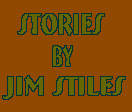

MAD MUTANTS & THE EXPLOITATION OF 'CACTUS ED'
After surviving the last two issues--I survived producing them and you survived reading them--it seemed like a good idea to lighten up a bit. I mean, after all, just how much despair and confrontation and self-flagellation can any of us endure in a calendar year?
I sensed this might be a good idea months before the 'Mirror' and 'Feedback' issues even went to press and so, way back last winter, I penciled in the 'Mad Mutants of the West' issue for August/September. My plan was to find four or five writers, plus myself, to knock out 2000 words or so on five or six 'characters' who are so weird...no...that's not the right word. So unique as to deserve a tribute to their 'special personalities' in this publication. Two requirements needed to be met. First they had to be interesting enough to hold the readers' interest for two pages and, second, half of them needed to be women. Or men, depending on your point of view. In these politically correct times, gender balance is crucial and so I sought men and women to write stories about mutated men and women. I failed miserably.
One by one, the would-be mutants refused the title and consequently the writers bailed. Women particularly, seemed offended by the honor I was attempting to bestow upon them. When the mass exodus from Mutantom was over, a trio of brave men were left standing. They are three of most entertaining and talented (in their own strange way) guys you could ever fear to imagine. And I know them all--know them from the Abbey days because they were all friends of Ed's. Suddenly it struck me like a lightning bolt..."Three of Abbey's Pals." Of course.
I mentioned this idea to a friend of mine, a crazed woman in her own right who suffers severely from an unnatural obsession with the great Cactus Ed and within days, word of the "Pals of Ed" issue had been posted on the Abbey web site.
The Abbey web site is a gathering place for people who admire and respect Abbey but who have way too much time on their hands. If Abbey were here, he'd offer the same admonition to them that William Shatner once gave to Trekkie conventioneers--"Get a Life!"
But the posting did serve a useful purpose. A few days later, I received an email from writer Jim Cahalan. For the last several years, Cahalan has devoted much of his time and energy to, what he hopes will be, the definitive biography of Edward Abbey. I can certainly vouch for his intensity; he called me several times and we spoke for hours about Ed, and I was really a minor figure in Abbey's life. Cahalan tells me that his phone conversations with Abbey's great friend John DePuy set endurance records with AT&T.
Ultimately Cahalan's latest phone call led to the publication of an excerpt from his forthcoming biography, Edward Abbey: A Life, in this issue.
One day last week, I was swilling coffee at Dave's Corner Market and yet another friend of mine said, "So I hear you're doing another glorification/exploitation issue on Abbey."
"Yes," I replied. "I think he'd be thrilled."
But her comment did give me pause for a moment. Am I just as goofy as the Abbey Webbed People? Am I exploiting the memory of this great man? I concluded that...no...I am not nearly as goofy as the Webbed People and yes, I am exploiting Cactus Ed to certain extent. And again, I think he'd be amused, if not "thrilled."
I remember a conversation with Abbey, a year or two before his death in 1989; the topic was nothing if not a blatant attempt to exploit his name and reputation. I had a plan to get rich and Ed was fully supportive, as long as he could share in the wealth. Here was the deal. During my own obscenely long stay at Arches National Park as a seasonal ranger, I had witnessed the long and steady stream of pilgrims who came to Arches just to visit The Site.
Of course, I speak of Ed's trailer site at the Monument during the 1956/57 seasons. Decades later, the trailer was gone and most of the other artifacts had been picked clean (The last rusty Ed Abbey beer bottle cap was dug up and claimed by a tourist from Lawrence, Kansas in 1979). But what still remained at the time was a corroded segment of Ed's leach field pipe.
When the Park Service installed the old trailer, there wasn't enough real soil to build a proper septic system and underground leach field. So the Park Service laid the pipe on the bare slickrock and then simply covered it with a lot of Moenkopi shalestone. It would not pass health codes today.
Over the decades, the Moenkopi eroded away and the pipe was exposed.
I contemplated a use for this pipe for years. Finally I went to Abbey with a proposition. What if we cut this pipe into one inch sections and mounted it on an attractive wooden plaque with the brass plate that reads:
Authentic Edward Abbey Leach Field Pipe
Arches National Monument, 1956-1957
"Ed Abbey crapped through this pipe."
Ed nodded enthusiastically. "Yes!" he said. "And I could autograph each one of them. Not only would it authenticate the plaque but we could get more money for it."
But I think I hurt his feelings when I suggested a $19.95 asking price.
"Christ," he complained. "We ought to get more for it than that."
The idea never came to fruition. Thieves made off with the pipe, Ed moved on, and I lost interest in the project. But I think he'd be agreeable to the "exploitation" of his good name in this particular issue of The Zephyr. Besides he was always ready to lend a hand to a fellow artist. If an endorsement from Ed will help Greenspan get new gigs, help DePuy sell more art, or find new buyers for Tom's VW collectibles, I think he'd be pleased.
A CHALLENGE TO MY FELLOW INDEPENDENT PUBLISHERS
As I mentioned earlier, the last two issues of The Zephyr were self-scrutinizing confessionals in a way. How, we asked, are environmentalists contributing to the degradation and destruction of the wild lands we all claim to cherish? We're all hypocrites to one degree or another, and I struggle with my own contradictions and hope I can do better.
There are a lot of small independently owned newspapers and periodicals in the Intermountain West, although we're seeing many of them bought up by regional and national publications at an alarming rate. But for those indies that have eluded the corporate grasp, you have the freedom to print what you want.
I'd like to encourage all my fellow wild cat publishers to give up "how to get there" stories. You know what I'm talking about--the two page spreads, with photographs and side-bars that tell you how to find the West's ever-dwindling number of seldom visited gems and what to expect to find when you get there. When you're finished reading these articles, very little is left to the imagination. They'll tell you precisely where to turn from the pavement to the two-track. They'll tell you where to park. They'll tell you what "special features" you can expect to see and with precise mileage measurements. Is there water? They'll let you know.
What an adventure!
So let's quit printing this drivel. If writers can't think of a topic any better than this, if they're no more imaginative than this, then they should certainly find another line of work. The same goes for the publishers. "How to get there" articles have no literary value and are, in fact, extremely dangerous and counterproductive filler material. With all the problems facing the West's dwindling wilderness, you'd think we could find stories that better reflected our concern and our desire to help save it. Printing road maps with words of the "Last Secret Places" only contributes to their demise.
REMEMBERING THE PROPANE FIRE
Twenty years ago on a Saturday night, July 31, 1981, Moab, Utah suddenly and explosively became the lead story on the national news. It was monsoon season and we all grow accustomed to late afternoon and evening thunderstorms in the canyon country. In fact, we look forward to the relief these storms often bring from the hot desert days.
But just past sunset, a lightning bolt struck and exploded the propane tanks north of Moab and just adjacent to the Slickrock Campground. A fireball of ignited gas spewed from the end of the tanks and sprayed the north end of the campground like a giant flamethrower.
As the fire raged out of control, it became clear that vast underground storage facilities on site, holding millions of cubic feet of propane, could ignite as well. In fact, it was possible that such an explosion had the power to destroy the entire north end of Moab.
I was a seasonal ranger at Arches, stationed at the Devils Garden Campground, and on this particular evening was looking forward to a quiet dinner with the lovely Dana Blum...the Georgia Peach. Dana was a Student Conservation Aid at the park that summer and I had been begging unsuccessfully for two months for a date. Now finally Dana had relented. We had just sat down for dinner when I heard a crackling and broken transmission on the two-way radio. Beyond the static I could hear the urgency in his voice. It was NPS Ranger Carl Douhan and he was calling for "all units equipped for medical evacuation! Report to Allen Memorial Hospital!"
I stared briefly at Dana, who looked lovely beyond words on that evening, and then at the microphone. Then at Dana again. I do not believe this. But I knew I had to call in; we kept the park ambulance at the campground and it sounded as if it was needed. At the time I had no idea just how critical the situation was. I left Dana and the cheeseburgers and headed "down the hill" as we used to say, toward the park visitor center.
When I reached the switchbacks above the Arches entrance, I was stunned by the view. All traffic had been stopped by law enforcement and the line of trucks and cars stretched up the Moab Canyon and out of sight.
I called Douhan again and the orders were the same, so I pulled onto the emergency lane of US 163 (now US 191) and bypassed three miles of the traffic jam. I crossed the Colorado River bridge and was stopped at the river road junction by Moab Volunteer Fireman Corky Brewer. Corky and crew had pulled back from the fire and now they stood helplessly beside their pumper, expecting the worst.
"Corky, I got called to report to the hospital. Is it ok to go?"
"Hell NO," Corky replied. "Those underground tanks could blow at any moment. Even we backed off. I wouldn't go to Moab if I were you."
But I was stupid and running on pure adrenalin by now and told him I thought I'd give it a try.
"It's your funeral," he said. "Good luck."
I punched the accelerator and off we went (I'd collected two more rangers at the visitor center). As we approached the Doxol plant, I was concentrating on the road and my speedometer as I passed 85 mph. But it was impossible to ignore the orange tongue of flame still leaping from the end of the tank.
"Damn," I muttered as the park ambulance shot past.
Luck was on my side and we found our way to the hospital through the crowds and congestion. By the time we arrived, the injured had been flown to Grand Jct. by LifeFlight and I found myself doing "looting patrol," although there seemed little if any threat of such activity--everyone was too scared to think criminally. My greatest concern was for my friend Reuben Scolnik, a retired NASA engineer who spent most of his summers in those days searching for arches. Reueben's trailer was directly adjacent to the propane plant; only a wooden fence separated him from the explosion. Earlier, as I raced past the inferno, it was clear that the fence had been incinerated by the blast.
Now word came that there were fatalities among the injured and I feared the worst for my good friend. We wandered the streets of north Moab aimlessly, assisting when we could, but offering no real news. It was a long dark night.
Finally, an hour before dawn, the sheriff's office announced that the threat of any greater explosions had passed, thanks mainly to the heroic efforts of Doug Farnsworth. Doug, an employee at the propane plant, had plunged into the flames just after the explosion to shut off critical valves. Had he not risked his life to cut off the propane to the underground tanks, many additional lives may have been lost.
Finally, we were "released" to return home and I headed straight for the campground. I had to know about Reuben. By now hundreds of people had descended upon the campground and all of it was illuminated by harsh and un-worldly emergency spotlights. All I could see was a mass of strained faces. Then, through the unfamiliar throng, I spotted a familiar sight---a godawful powder-blue, sweat-stained pork-pie hat that Reueben Scolnik wore 18 hours a day. His tired but relieved face was under it.
It had been a close call for my friend. The fireball passed within fifty feet of his trailer and four campers in a tent died in the fire. The red plastic running lights on Reuben's trailer melted from the heat (see photos, page 9), but otherwise he was okay.
I finally reached the campground at dawn. Dana was still there but fast asleep. She'd left me a note, in case we somehow missed each other. "The cheeseburgers were great. Sorry you weren't here to eat them."
It didn't matter. I was too wound up to eat or sleep. I just stood there, in that shabby little trailer, listening to the hum of my refrigerator. Then someone knocked on my door to complain about a plugged up toilet in comfort station #3.
"We're having a real crisis up there with no toilet, ranger."
All I could do was smile. You have no idea.







